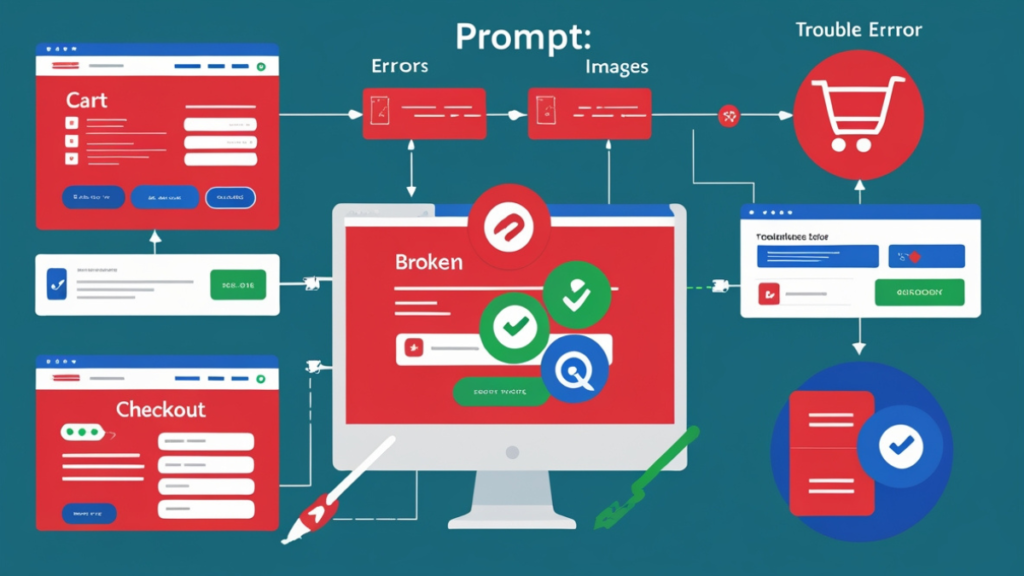Introduction
E-commerce websites face numerous challenges in providing a seamless user experience. If you’re running an online store, you must be aware of the most common e-commerce website errors and how to fix them. These errors can harm your sales, frustrate customers, and lower your search engine rankings. In this article, we will explore common mistakes and provide actionable solutions to improve your website’s performance, SEO, and user satisfaction.
1. Slow Website Loading Speed
The Impact of Slow Website Speed
Website speed is crucial for both SEO and user experience. If your e-commerce website takes too long to load, visitors may leave before making a purchase. Google also uses website speed as a ranking factor, which means that slower websites may be penalized in search engine results.
How to Fix It
- Optimize images: Large, unoptimized images can significantly slow down a website. Compress images without losing quality using tools like TinyPNG.
- Use a Content Delivery Network (CDN): A CDN helps distribute your website content across various servers worldwide, reducing load times.
- Enable browser caching: This allows browsers to store certain resources, making subsequent page loads faster.
- Minimize HTTP requests: Reduce the number of elements on your page, such as images, scripts, and CSS files, to lower HTTP requests.
By addressing these issues, you can greatly improve your website’s loading speed and reduce bounce rates.
2. Broken Links
Why Broken Links Are Problematic
Broken links are one of the most common e-commerce website errors. They negatively impact user experience, frustrate visitors, and hurt your SEO rankings. If users click on a link that doesn’t work, they might leave your website, resulting in lost sales.
How to Fix It
- Regularly check for broken links: Use tools like Screaming Frog to regularly crawl your site for broken links.
- Fix or redirect broken links: Update or redirect broken links to relevant pages, ensuring that users are sent to the correct destinations.
- Monitor for 404 errors: Implement a custom 404 error page that guides users back to important sections of your site or suggests popular products.
By fixing broken links, you can improve your site’s usability and SEO performance.
3. Poor Mobile Optimization
The Rise of Mobile Shopping
More consumers are shopping on mobile devices than ever before. In fact, over 50% of e-commerce traffic comes from mobile devices. If your website isn’t optimized for mobile, you may be losing a significant portion of potential customers.
How to Fix It
- Responsive design: Ensure your website uses a responsive design that adapts to different screen sizes. This guarantees that your site looks great on any device.
- Optimize mobile checkout: Make the checkout process as simple as possible on mobile. Use large buttons, streamline forms, and eliminate unnecessary steps.
- Test your mobile site: Regularly test your mobile site on various devices to ensure functionality and user-friendliness.
Investing in mobile optimization is essential for retaining customers and boosting sales.
4. Complicated Checkout Process
Why a Complicated Checkout Process Hurts Sales
A lengthy or complicated checkout process can lead to cart abandonment. When customers are forced to go through too many steps to complete a purchase, they may abandon their cart and leave your site without buying anything.
How to Fix It
- Simplify the checkout process: Offer a guest checkout option, reduce the number of form fields, and allow users to easily edit their cart.
- Use progress indicators: Show customers how many steps are left in the checkout process to reduce anxiety and improve the user experience.
- Offer multiple payment options: Provide various payment methods, such as credit/debit cards, PayPal, and Apple Pay, to cater to different preferences.
Making checkout easier will help reduce cart abandonment and increase conversions.
5. Missing Product Information
Why Product Information Is Critical
One of the most common e-commerce website errors is incomplete or missing product descriptions. Customers rely on product details, images, and specifications to make informed purchasing decisions. Without clear and accurate information, customers may hesitate to buy from your store.
How to Fix It
- Provide detailed descriptions: Ensure each product has a clear and comprehensive description, including size, color, material, and features.
- Use high-quality images: Include multiple images of your products from different angles. Use zoom functionality to help customers get a closer look.
- Add customer reviews: Allow customers to leave reviews, providing social proof that your product is of high quality.
Improving product information helps build trust and increase conversions.
6. Poor Search Functionality
Why Search Functionality Is Essential
When users can’t find the products they’re looking for quickly, they may leave your site and search elsewhere. A poor search experience can lead to frustration and lost sales.
How to Fix It
- Implement an advanced search feature: Include filters that allow users to narrow down results based on categories, price range, and other attributes.
- Optimize for spelling errors: Use auto-correct and suggestions to help users find products even if they misspell search terms.
- Display relevant results: Ensure that search results are accurate and relevant to what the user is looking for.
A well-designed search feature can enhance user experience and increase conversion rates.
7. Security Issues
Why Security Matters for E-Commerce Websites
Security is a top priority for any online store. Customers need to feel confident that their personal and payment information is safe. Failing to provide a secure shopping environment can result in lost sales and damage to your brand reputation.
How to Fix It
- Use HTTPS: Ensure that your website uses SSL encryption (HTTPS) to secure data transfer between the user’s browser and your site.
- Comply with PCI DSS standards: Follow the Payment Card Industry Data Security Standards to protect sensitive customer data.
- Enable two-factor authentication: Add an extra layer of security for customer accounts and payment information.
By focusing on security, you can build trust with your customers and protect your business from potential threats.
8. Lack of Clear Calls-to-Action (CTAs)
Why CTAs Are Important
A CTA (Call-to-Action) prompts users to take a specific action, such as adding a product to their cart or signing up for a newsletter. Without clear CTAs, visitors may not know what to do next, leading to missed sales opportunities.
How to Fix It
- Use prominent buttons: Make sure your CTAs are large, eye-catching, and clearly labeled (e.g., “Add to Cart” or “Buy Now”).
- Place CTAs strategically: Position CTAs in visible areas, such as at the top of product pages, near product images, and at the end of product descriptions.
- Keep CTAs simple: Use short, action-oriented text that tells the user exactly what to do.
Clear CTAs guide customers through the buying process and increase conversions.
9. Inadequate Customer Support
Why Customer Support Matters
Customers may have questions or encounter issues while shopping online. If they can’t easily get help, they might abandon their purchase or leave negative reviews.
How to Fix It
- Provide multiple support channels: Offer live chat, email support, and a phone number for customers to contact you.
- Create a comprehensive FAQ section: Address common customer questions about shipping, returns, and product details.
- Respond promptly to inquiries: Aim to respond to customer queries within 24 hours to maintain a positive experience.
Great customer support can improve retention and encourage repeat purchases.
Conclusion
By addressing these common e-commerce website errors, you can significantly enhance your site’s performance, improve the user experience, and boost your sales. From fixing slow load times to optimizing your checkout process, every improvement counts. For further assistance in optimizing your e-commerce website, check out Codinov for the best streaming services and web solutions.


